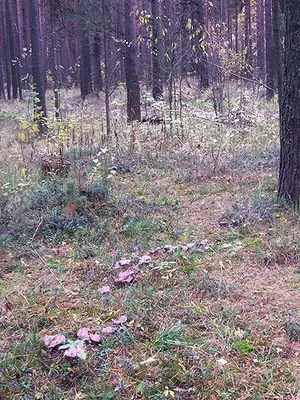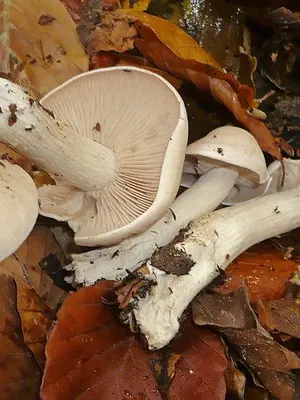 The forests of Primorsky Krai are unusually “prolific” for mushrooms. Here grow such types of fruiting bodies that are not found at all in other regions of the Federation, or are found, but very rarely. According to experts, about 800 species of mushrooms grow in this area, 300 of them are edible.
The forests of Primorsky Krai are unusually “prolific” for mushrooms. Here grow such types of fruiting bodies that are not found at all in other regions of the Federation, or are found, but very rarely. According to experts, about 800 species of mushrooms grow in this area, 300 of them are edible.
Row mushrooms are not considered popular, but this is an amazing and diverse species in the mushroom “kingdom”. Rows grow in large groups, or rather, in rows, which characterizes their name. In a small area, you can pick up a couple of baskets of these mushrooms. Almost all forest areas in Our Country are rich in these fruiting bodies. Row mushrooms are also found in the Primorsky Territory.
The aroma and taste of seaside rows is very high, this is especially noticeable in young mushrooms. In this territory, 2 types of rows are considered the most common: gray, as well as pink or violet. However, many “silent hunting” lovers usually do not collect these fruiting bodies, because they are afraid to confuse them with inedible and poisonous species. In addition, the rows require a special approach – they must be soaked and boiled in salted water.
The rows of Primorsky Krai are divided into spring, summer, and autumn species. In addition, they are divided into edible, conditionally edible and poisonous mushrooms.
As already noted, pink and gray species are the most popular edible mushrooms in Primorsky Krai, so we offer photos of these fruiting bodies.


They usually grow in deciduous forests, with predominantly growing oaks. They can also be found in mixed and coniferous forests. These are edible species of rows, but they look intimidating because of their unusual color. If a mushroom picker does not know how to identify such fruiting bodies, he will never pick them, thinking they are toadstools.
Any edible mushrooms growing in the Primorsky Territory, including conditionally edible species, must be subject to preliminary heat treatment in the form of boiling for 20 minutes to 40 minutes, depending on the size.
[ »]
Mushroom pink row in Primorye
We suggest that you familiarize yourself with the photo and description of the fungus of the row of the Primorsky Territory – the row of violet or pink.
Latin name: Get over it.
Family: Ordinary.
Sort by: Lepista.
Synonyms: violet rowing, violet or pink lepista.


Hat: diameter from 4 to 15 cm, fleshy, large. The shape of the cap in young specimens is cushion-shaped, then prostrate. In adult mushrooms, the edges of the cap are uneven with cracks. It has a pinkish-brown color, with a darker shade in the center.
Leg: large, massive from 1 to 2 cm in diameter. Height from 5 cm to 10, sometimes up to 12 cm with an extended base. Creamy white or pink. On the surface of the stem are characteristic vertical strokes, sometimes not very noticeable.
[ »»]
Pulp: white, turns pink when broken, dense, thick with a pleasant violet smell and sweet taste. The flesh of the leg is quite hard and fibrous.
Records: free and frequent, not reaching the massive stem. In young specimens, the plates are whitish in color, which become pink over time.
Spore powder: pink.
Application: used in cooking in any form, perfectly lends itself to various processing processes, including pickling and salting. For medical purposes, violet rowing is not used.
Edibility: edible mushroom, reminiscent of the taste of purple or lilac rowing.
Similarities and differences: very similar to a white smoky talker. However, the latter has an unpleasant odor and loose leg pulp.
Spread: the autumn view of the pink row in Primorye grows in deciduous and mixed forests, less common in coniferous. The harvest season is in September and October. It grows in wide rows or forms the so-called “witch circles”.
[ »wp-content/plugins/include-me/ya1-h2.php»]
Mushroom gray rowing in the south of Primorsky Krai
[ »wp-content/plugins/include-me/goog-left.php»]
Another common type of rowing mushroom in Primorye is the gray rowing mushroom. Mushroom pickers claim that the mushroom can be eaten in any form – salted, pickled, fried, stewed, frozen and even cheese.
There is a gray row in the temperate zone of the region. Grows on any type of soil and even forest floor, from September to mid-November. The peak of collection is in mid-September and early October. Gray rows growing in Primorye have amazing taste, although they belong to the 4th category of edibility. They are used to prepare a wide variety of dishes. In addition, these mushrooms are great for pickling, pickling, frying, stewing.
In the south of Primorsky Krai, gray row mushrooms prefer to grow in pine or mixed forests, especially where there is a lot of moss and fallen leaves. Although their color is not too bright, mushrooms are easy to find on the surface of the soil, they grow in large groups or rows.
We offer you to look at a photo of a row growing in the Primorsky Territory and get acquainted with the description of this mushroom.
Latin name: Tricholoma portentosum.
Family: Ordinary.
Sort by: Trichol.
Synonyms: gray sandpiper, hatched row, podsosnovik.

Hat: from 4 cm to 12 cm in diameter, fleshy, with a tubercle in the center, smooth to the touch. Young fruiting bodies have a round-conical shape, which becomes flat with age, almost prostrate with some irregularities. The wrapped edges of the cap crack with age and bend upwards. The color varies from dark gray to light gray with an admixture of olive or purple hues. The color of the surface of the cap is uneven, with a darker middle. When it rains, the hat becomes slippery and sticky. Pay attention to the photo of the row mushroom found in Primorsky Krai:


Leg: has a cylindrical shape with a wide base. Height up to 10-12 cm with a diameter of up to 3 cm, fibrous. In young mushrooms, the stem structure is solid and dense, in older mushrooms it is hollow. Very often the leg is completely immersed in moss or deciduous-coniferous litter. The color is grayish with some yellowness, in the upper part of the leg is covered with powdery coating.
Pulp: gray or off-white, may turn yellow when broken. Dense, has the smell of freshly ground flour and a pleasant taste.
Records: fairly wide, winding, rare, white. In adulthood, the plates acquire a gray tint.
Edibility: edible mushroom category 4.
Spread: seaside mushrooms prefer coniferous and mixed forests, where the main condition is the presence of pine. It is with these trees that the gray rows like to form mycorrhiza. They grow from September until frost, bear fruit together, forming large and wide rows or circles of gray mushrooms.









